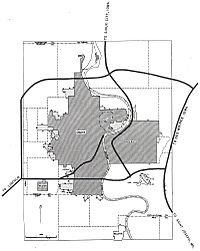History of Omaha, Nebraska facts for kids
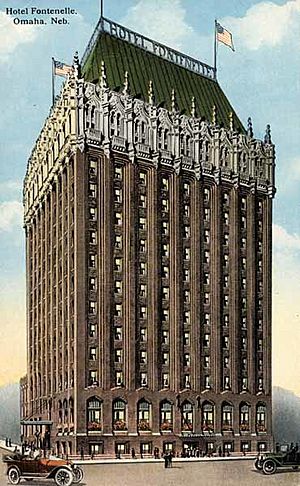
The history of Omaha, Nebraska began long before the city was officially founded. People from nearby Council Bluffs, Iowa started claiming land across the Missouri River in the 1840s. Later, William D. Brown used his Lone Tree Ferry to bring settlers from Council Bluffs to the Omaha area. A special agreement with the Omaha Tribe led to the creation of the Nebraska Territory, and Omaha City was officially started on July 4, 1854.
Early settlers faced challenges with land claims. A group called the Omaha Claim Club formed to handle land disputes. Their actions helped many of the city's first leaders get land in an area called Scriptown. Eventually, a case decided by the U.S. Supreme Court, Baker v. Morton, ended the club's power.
Omaha quickly grew to be the largest city in Nebraska. Even after losing its role as the Nebraska State Capitol to Lincoln in 1867, business leaders worked hard to make Omaha a success. They built the Jobbers Canyon downtown to supply farmers across the Midwest. Their success allowed them to build large homes in areas like Kountze Place and the Old Gold Coast.
In the 1870s, the Omaha Stockyards and meatpacking plants grew rapidly. This led to new neighborhoods like Sheelytown for workers. Omaha grew so fast it was called the "Magic City." The late 1800s also saw the creation of groups like the Knights of Aksarben. In 1898, the city hosted the Trans-Mississippi Exposition, a huge fair that attracted many visitors. Omaha University was founded in 1908.
By the 1930s and 1940s, Omaha was a major center for meatpacking. Several local beer companies, like Metz, Storz, and Krug, also became popular. In the late 1940s, the Strategic Air Command made its home in nearby Bellevue, Nebraska. In 1950, Rosenblatt Stadium in South Omaha became the home of the College World Series. After World War II, people in Omaha, especially African American veterans, began to push for equal rights, leading to the city's Civil Rights Movement.
From the 1950s to the 1970s, many people moved to newer homes in West Omaha. This led to changes in older neighborhoods like North and South Omaha, which became more focused on certain groups and income levels. Many workers in these areas lost their jobs as industries changed, leading to more economic challenges.
Contents
Early Inhabitants and Explorers
Omaha's location near where the Missouri River and Platte River meet has always been important. Before European settlers arrived, many Indian tribes lived in the area. These included the Pawnee, Otoe, Sioux, Missouri, and Ioway tribes. They often moved around the Great Plains to find food. The Pawnee and Otoe tribes lived here for hundreds of years. The Siouan-speaking Omaha tribe arrived from the Ohio Valley in the early 1700s. The word "Omaha" (Omaha–Ponca: Umoⁿhoⁿ) means "Dwellers on the Bluff."
In the late 1700s and early 1800s, the Omaha nation was very powerful along the Missouri River. After a smallpox outbreak, changes to their way of life, and the disappearance of the buffalo, the Omaha tribe sold their remaining land in 1856. They then moved to their reservation in Thurston County, Nebraska.
European Explorers Arrive
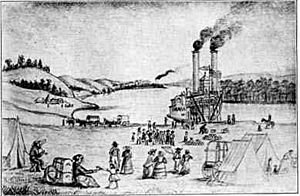
On July 21, 1804, the Lewis and Clark Expedition sailed past the future site of Omaha. They camped near present-day Bellevue for five nights. On July 27, William Clark and Reuben Fields explored mysterious mounds near what is now 8th and Douglas Streets in Downtown Omaha. They later camped near today's Eppley Airfield. The expedition met the Otoe tribe about 20 miles north of Omaha. The first recorded black person in the Omaha area was "York," an enslaved African American who traveled with William Clark.
Other explorers and traders also visited the area. The Astor Expedition came through in 1811. Stephen Long explored the Omaha area in 1819. Later, fur traders set up posts like Fort Lisa (1806), Fort Atkinson (1819), and Cabanne's Trading Post (1822).
In 1825, a fur trader named J.B. Royce built a trading post near what is now Dodge Street and Capitol Avenue. This post was later abandoned. In the 1840s, Mormons built a town called Cutler's Park in the area before continuing their journey west on the Mormon Trail.
In 1854, Logan Fontenelle and the Omaha Tribe sold most of their land, about four million acres, to the United States. This allowed the Nebraska Territory to be settled and Omaha City to be founded. The Kansas–Nebraska Act created the Territory with the condition that it would remain slave-free.
Omaha's Pioneer Days: 1853 to 1867

In 1853, William D. Brown ran the Lone Tree Ferry. It carried gold prospectors and settlers across the river from Kanesville, Iowa to the Nebraska Territory. The ferry company later became the Council Bluffs and Nebraska Ferry Company. "Omaha City" was planned by the ferry company owners. They hoped to attract the proposed First transcontinental railroad to Council Bluffs. Alfred D. Jones, Omaha City's first postmaster, mapped out the town in early 1854. The first black person arrived in Omaha in 1854.
In the early days, there was no formal police or sheriff. So, many pioneers formed a "claim club" to create their own rules, especially about land. The Omaha Claim Club controlled many aspects of the new city. Ten years after the city started, early citizens also formed the Old Settlers' Association to record the city's history.
Other early towns near Omaha included Bellevue (settled 1804, founded 1853), East Omaha (1850s), and Saratoga (1857). The town of Florence was planned in 1854 and founded in 1855.
The first minister in Omaha was Moses F. Shinn, a Methodist Episcopal Church leader. Many of Omaha's early pioneers, including politicians and soldiers, were buried at Prospect Hill Cemetery. Starting in 1887, Douglas County began burying poor people or those with no known identity in Potter's Field. Today, Forest Lawn Cemetery maintains Potter's Field.
The Nebraska State Capitol moved from Omaha in 1867.
Nebraska's First Capital
In late 1854, Omaha was chosen as the capital for the Nebraska Territory. In 1855, a group of businessmen formed the Omaha Land Company. They gave away land in Scriptown to Nebraska Territory legislators who voted to keep Omaha as the capital. After the Baker v. Morton case in 1857, this type of land deal became illegal. By then, Scriptown had already become part of neighborhoods like Gifford Park and Prospect Hill.
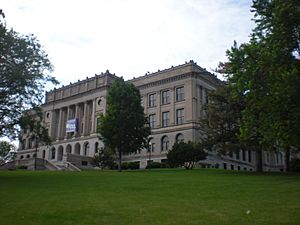
The small city struggled during the economic Panic of 1857. However, having the capital there helped the town survive. For several years, Omaha enjoyed being the capital, though there was some disagreement. In January 1858, some representatives tried to move the Nebraska Territorial Legislature to Florence after a fight at the Capitol in Omaha. Even though they had enough votes, the "Florence Legislature" did not convince the governor. The Capitol stayed in Omaha until 1867, when Nebraska became a state. When Omaha finally lost the capital to Lincoln in 1867, the city was strong enough to continue growing.
Growing Businesses
Council Bluffs was chosen as the starting point for the United States' first transcontinental railroad in 1862. However, construction began west from Omaha to avoid building a bridge over the Missouri River right away. This made Omaha a major transportation hub for the country. The Omaha Cable Tramway Company was the only cable car company in Omaha, operating from 1884 to 1894. Warehousing became very important, with the Jobber's Canyon playing a big role.
Development and Growth: 1868 to 1899
New towns founded during this time included Benson (1887), Dundee (1880), Elkhorn (1865), Papillion (1870), Ralston (1888), South Omaha (1886), and Millard (1871).
In 1856, the Omaha Claim Club donated land for a church. Soon, many different religious groups built churches. Catholics dedicated St. Philomena's Cathedral in 1856. The Creighton family, including Edward, his wife Mary, and his brother John, strongly supported the Catholic Church. Pioneer banker Augustus Kountze helped fund the first Lutheran church west of the Missouri River, which was later renamed Immanuel Lutheran Church. In 1871, Omaha's Jewish community bought land for their first cemetery.
In 1879, the important trial of Standing Bear v. Crook took place at Fort Omaha. During the trial, General Crook spoke on behalf of Standing Bear. This led the court to recognize American Indians as persons for the first time in a U.S. Federal Court.
In the 1880s, Omaha was one of the fastest-growing cities in the United States. After James E. Boyd started the first meatpacking operation in the 1870s, thousands of immigrants from central and southern Europe came to Omaha. They worked in the Union Stockyards and slaughterhouses of South Omaha. These immigrants created Omaha's first ethnic neighborhoods, such as Sheelytown, Greek Town, Little Italy, Little Bohemia, and Little Poland. Other neighborhoods founded during this time included Bemis Park and Field Club. The Near North Side also grew, with many Jewish and German residents, and the first groups of African Americans.
Omaha's growth in the 1880s was boosted by the rapid development of the Union Stockyards and the meat packing industry in South Omaha. The "Big Four" meatpackers were Armour, Wilson, Cudahy, and Swift. Several breweries also opened, including Storz, Krug, Willow Springs, and Metz.
Culture in Omaha also grew a lot during this time. As the population increased, many social and community groups formed. The city's main newspapers, the Omaha Bee and the Omaha World-Herald, were founded in 1874 and 1885. Omaha was the site of the 1892 convention that formed the Populist Party, which created the Omaha Platform for farmers.
In 1894, the Ladies Auxiliary of the Ancient Order of Hibernians, an Irish-Catholic organization, was founded in Omaha. That year, the city also hosted the first African-American fair in the United States. The next year, the Knights of Ak-Sar-Ben, a civic and charity organization, was founded.
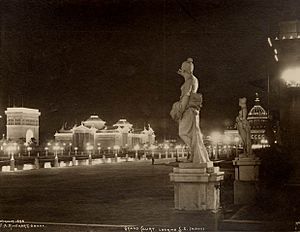
The Trans-Mississippi Exposition was held in North Omaha from June 1 to November 1, 1898. This huge fair attracted over 2 million visitors. It involved building attractions across 100 city blocks, including a lagoon, bridges, and grand buildings made of plaster. The Exposition also featured shows like Buffalo Bill's Wild West Show.
Modern Omaha Begins: 1900 to 1941
In the decades before World War II, Omaha experienced a time of growth. The city saw rapid development, cultural expansion, and a large increase in population. African Americans were recruited to work in the meatpacking industry and moved North in the Great Migration after 1910. Many Polish workers also immigrated during this time. New residents created communities throughout the city, and older immigrant groups became more integrated. The city grew north and south of Downtown Omaha. In the early 1910s, the city's Automobile Row grew along Farnam Street.
The city faced hard times during the Great Depression. Government programs like the Works Progress Administration (WPA) and Civilian Conservation Corps (CCC) helped many men find jobs building parks and community facilities. At this time, farms still surrounded the city's core, with buildings like the Ackerhurst Dairy Barn showing this agricultural past.
Sports in Omaha
Omaha University was founded in the Redick Mansion in the Kountze Place neighborhood in 1908. It moved to its current campus in 1929.
Omaha has had several baseball teams. The Omaha Omahogs started in 1900. Their name changed to the Omaha Indians in 1902, then the Omaha Packers in 1904, and the Omaha Rourkes in 1906. They were the Omaha Buffaloes from 1921 to 1928, and the Omaha Crickets in 1929. In 1930, they became the Omaha Packers again until 1935. A new team, the Omaha Robin Hoods, formed in 1936, and later became the Omaha Cardinals.
The Easter Sunday Tornado
In 1913, a powerful tornado, known as the Easter Sunday tornado, struck Omaha. It killed over 100 people and destroyed hundreds of homes. It cut a path through the city, including the heart of North Omaha's Jewish and African-American business area, which suffered the most damage.
The Omaha Race Riot
After World War I, social tensions were high as soldiers returned and people competed for jobs. After a summer of similar events in other cities, Omaha experienced the Omaha Race Riot in 1919. The city needed help from Federal troops to stop the disorder. The troops were sent to South Omaha to prevent more crowds and to North Omaha to protect African Americans.
Social and Cultural Changes
Job's Daughters International, a youth organization for girls, was founded in Omaha in 1920. Aleph Zadik Aleph, a youth group for boys, started in 1923.
In 1925, Malcolm X was born (as Malcolm Little) at 3446 Pinkney Street in North Omaha. His family moved away when he was young due to threats.
The Nebraska chapter of the National German-American Alliance (NGAA) was founded in 1907 by Valentin J. Peter, who published the German-language Omaha Tribune. By the 1920s, the organization worked with breweries to support German immigrants. Peter's business, the Interstate Publishing Company, still operates in Omaha today.
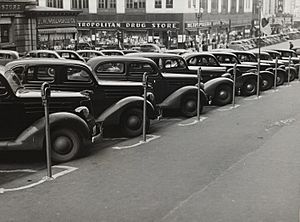
World War II Efforts
In 1945, the Enola Gay and Bockscar, famous B-29 bombers, were among 536 B-29 Superfortresses built at the Glenn L. Martin Aircraft Factory (now Offutt Air Force Base) in Bellevue.
That same year, a Japanese fire balloon exploded over Dundee. This was part of a World War II effort by Japan to cause problems in American cities. The story was kept secret by the American military until after the war, as no one was hurt.
Civil Rights Movement Era
Civil rights activism in Omaha began in 1912 with a local chapter of the National Association for the Advancement of Colored People. It continued with leaders like Whitney Young, George Wells Parker, and Harry Haywood. Other groups, such as the Citizens Civic Committee for Civil Liberties (4CL) and the DePorres Club at Creighton University, formed in the 1940s. Mainstream organizations like the Omaha Urban League also supported the movement.
Their efforts led to the end of unfair housing practices and the start of a school integration plan. In the late 1960s, the student-led Black Association for Nationalism Through Unity (BANTU) became more active.
Transformation: 1950 to 1999

In 1950, the NCAA moved the College World Series (CWS) to Rosenblatt Stadium in Omaha. The tournament had been held in other cities since 1947. Since 1950, the series has been held every year at Rosenblatt, despite other cities wanting to host it. Over 6 million fans have attended CWS games in Omaha. The city has often improved the stadium for fans, teams, and media. ESPN televised every game from 1980 to 1987. They started coverage again in 2003. From 1988 to 2002, CBS televised the championship game.
In 1955, the Omaha Cardinals baseball team joined the AAA American Association. That team ended in 1959. In 1961-62, the Omaha Dodgers were a farm team for the Los Angeles Dodgers. After six years without a professional team, the Omaha Royals started in 1969. The Omaha Royals became the Omaha Storm Chasers in 2011.
By the 1960s, the Omaha Stockyards were the world's largest livestock processing center. They surpassed Chicago's Union Stock Yards in the late 1950s. However, the industry changed in the 1980s and 1990s. Meatpacking plants moved to rural areas. All centralized stockyard activity declined, and the Omaha Stockyards closed in 1999. Today, new generations of immigrants, mostly Hispanic, work in meatpacking.
Weather was very severe in 1975. In January, a huge blizzard covered the city with snow. In May, the city was hit by a tornado. The Omaha Tornado of 1975 was an F4 tornado that tore through neighborhoods along 72nd Street on May 6, 1975. It killed 3 people and injured 133. It was the most expensive tornado in American history at that time, with damages estimated between $250 million and $500 million.
In 1988, Omaha tore down a downtown area of brick warehouses called Jobbers Canyon. This area was listed on the National Register of Historic Places. The demolition of Jobbers Canyon made way for the headquarters of ConAgra Foods and the city's Heartland of America Park. The loss of these buildings made citizens more aware of the city's historic places.
New Era: 2000 to Present
On August 20, 2001, Nebraska Methodist Health Systems tore down the Indian Hills Theater. This "super-Cinerama" movie theater had the largest indoor screen of its kind in the world. The site of the Indian Hills Theater is now a parking lot.
The downtown area has seen a lot of new construction since the late 1990s. Billions of dollars have been spent on projects like the Qwest Center Omaha arena/convention center, the Holland Performing Arts Center, the Gallup University campus, and new high-rise headquarters for First National Bank of Omaha and Union Pacific Railroad. The First National Bank Tower is the tallest building between Denver and Minneapolis.
On December 5, 2007, a mass shooting occurred at the Von Maur department store in the Westroads Mall in Omaha. A 19-year-old killed nine people (including himself) and wounded four.
On October 1, 2015, ConAgra Foods, a large company, announced it was moving its headquarters from Omaha to Chicago. This meant that many jobs would move or be eliminated in Omaha.
Historic Landmarks
Omaha has many historic buildings and sites. Some date back to before the city was founded. Many are recognized as important and are listed on the National Register of Historic Places. Sites like Fort Lisa and Cabanne's Trading Post were first used in the early 1800s. Landmarks from the mid-1800s include Culter's Park, or "Winter Quarters," in Florence, and Fontenelle's Post south of the city. Downtown has plaques marking Omaha's first building and first burial. The city has many landmarks in North Omaha, including the former town of Saratoga. South Omaha, Dundee, and Benson also have many historical landmarks. Kountze Park was the site of the 1898 Trans-Mississippi Exposition.
What Happened to Historic Sites?
The oldest historic sites in Omaha are in the Florence neighborhood. Other important sites include Capitol Hill, where Central High School now stands. This was where the city's founders had a picnic on July 4, 1854. Miller's Landing, where the Lone Tree Ferry brought settlers from Iowa, has been restored by the city. Prospect Hill Cemetery, where many of the city's founders are buried, is still in North Omaha. Jefferson Square, one of the city's first parks, was torn down in 1969.
From the 1950s to the 1980s, Omaha's urban renewal program involved tearing down many notable buildings. The Bee Building (built 1888, demolished 1966) and the Old City Hall were examples. The Old Post Office (built 1898, demolished 1966) was also torn down. These demolitions were controversial and helped start the landmarks preservation movement in the city. The Hotel Fontenelle, a fancy downtown hotel built in 1913, was torn down in 1983. Nearby Jobber's Canyon, a large industrial area with 24 buildings, was also demolished in 1989. This was a big loss of a nationally recognized historic district.
The birthplace of Malcolm X in North Omaha was torn down in 1965. The Gerald R. Ford birthsite was where the former president was born in 1913. The house was demolished after a fire in 1971.
The Metz Brewery opened in 1856. Its facility in Downtown Omaha closed in 1920 due to Prohibition. Willow Springs Distilling Company started brewing in the 1860s. Its main building was torn down in the 1970s. The company that became the Storz Brewery was founded in 1863. Storz built a large brewery in East Omaha with 15 buildings. Most were torn down by the 1990s. In 1894, the Krug Brewery in South Omaha built a brewery that was later bought by Falstaff. It was completely torn down by 1996. Frederick Krug, the brewery's founder, started Krug Park in Benson to promote his beer. In 1930, a serious roller coaster accident happened at Krug Park. The park closed 10 years later and became a public park in 1955. Another amusement park, Peony Park, closed and was torn down in the 1990s.
In 1938, the federal government built the Logan Fontenelle Housing Project to help working families. Over time, job losses and changes in the population led to problems. The buildings were torn down in 1995. The area is now being redeveloped with new housing.
The Omaha Stockyards were established in 1883. They became the world's largest stockyards by the late 1950s. The stockyards and meatpacking industry employed half of the city's workers. After decades of decline, the stockyards finally closed in 1999. All structures were torn down except for the Livestock Exchange Building. This building was recognized as important and listed on the National Register of Historic Places. The city has redeveloped the building into apartments and community spaces. The area is also becoming a new campus for the community college.
The Ak-Sar-Ben horse racing track was built in 1920, and the arena in 1929. Horse racing ended there in 1995. All buildings and grandstands were torn down by 2005. The Indian Hills Theater, a unique movie theater built in 1962, was torn down in 2001.
Historic Neighborhoods of Omaha
| Historic Neighborhoods in Omaha (Alphabetical Order) | |||||
|---|---|---|---|---|---|
| Name | Founded | Location | Notes | ||
| Bemis Park | North of Cuming between North 34th and Lincoln Boulevard | An upscale area designed for local doctors and teachers. | |||
| Benson | 1887 | North-central Omaha near 60th and Maple Streets | Home to Krug Park from 1900 to the 1930s. | ||
| Boys Town | 1917 | Near 132nd and Dodge Streets | This incorporated village is a famous institution. | ||
| Brown Park | Once home to many of Omaha's Mexican and Czech communities. | ||||
| Chinatown | 1910s | Formerly near 12th and Douglas Streets. | Centered around the On Leong Tong building. | ||
| Country Club | 1925 | 50th to 56th Streets, from Corby to Seward Streets | Added to the National Register of Historic Places in 2004. | ||
| Dundee | 1880 | Near 50th and Dodge Streets. | Became part of Omaha in 1915 after a dispute until 1917. | ||
| East Omaha | 1854 | East of Florence Boulevard, north of Locust Street, south and west of the Missouri River. | The first area added to the city in 1854. | ||
| Florence | 1846 | The original Winter Quarters settlement was here before Omaha. | |||
| Gold Coast | |||||
| Old Gold Coast | |||||
| Greek Town | In the heart of South Omaha. | ||||
| Keystone | N.72nd to N.90th, Maple st to Fort/Military Rd | The Keystone Trail starts at Democracy Park in Keystone. | |||
| Kountze Place | 1883 | A suburban area for wealthy business owners, once reached by streetcar. | |||
| Little Bohemia | South of downtown and west of Little Italy | Home to many Czech immigrants in the late 1800s and early 1900s. | |||
| Little Italy | South of downtown, east of Little Bohemia. | Located next to Little Bohemia. | |||
| Little Poland | |||||
| Midtown | |||||
| Miller Park | 1899 | Developed around 1900. | |||
| Minne Lusa | 1916 | Located south of the Minne Lusa Water Works. | |||
| Morton Meadows | |||||
| Near North Side | Cuming Street on the south, Locust Street on the north, 14th Avenue on the east and the North Freeway on the west. | Located just north of downtown. Once a diverse community with a thriving African American cultural scene from the 1920s to the 1950s. | |||
| North Omaha | A diverse area north of downtown Omaha with a rich history. | ||||
| Old Market | A downtown district that used to house food vendors and warehouses. | ||||
| Saratoga | 1856 | N. 24th and Ames Avenue | A former "boom and bust" town. | ||
| Sheelytown | South Omaha | Mainly an Irish immigrant neighborhood; Eastern European immigrants also settled there. | |||
| South Omaha | Once a separate city, it became part of Omaha in 1915. An area of European immigrant settlement, and more recently, Hispanic settlement. | ||||
| Scriptown | An area of land given to legislators who voted to keep Omaha the capital. | ||||
| Squatter's Row | An area between North 11th and North 13th Streets, from Nicholas to Locust Streets, behind the Storz Brewery. | For over 75 years, this area was lived in by squatters. | |||
|



